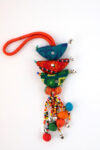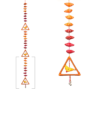The details of the products or product specifications (for instance weight, colour, handwork details, size, etc.) quoted with the product displays are only approximate values. While every endeavour has been made to accurately reproduce colours, there may be minor variations in colour of the actual product because of the nature of fabric dyes, weather at the time of dying and differences in display output due to lighting and digital photography and colour settings and capabilities of monitors. A customer must place an order keeping in mind this minor variation in colour as seen on a computer screen against the actual colour of the outfit received. It is practically impossible for Sahaj Designers to replicate the same colours on an outfit as seen on your monitor. A variation in the shade selected by you is considered as a normal practice as these garments have a tendency to reflect different shades of a colour under different light and weather, type of camera used for photography or type and settings on the computer monitor. We wish to clarify and ascertain that every customer who orders any outfit from Sahaj is aware of this genuine problem.
While ordering on internet, we suggest that customers should be extra careful of following –
- Red, maroon and orange colours have a higher tendency to reflect a different shade than other colours. For example even if you yourself try to photograph from a digital camera or scan a red garment, in most of the cases it will show either as maroon or orange on the computer monitor and vice versa. Though imaging technology has advanced, still no foolproof solution to this problem is available at the moment.
- Many a time’s green and blue shades also overlap. Same is the case with off-white, white and cream colours.
- Sea Green colour sometimes looks Aqua blue and the other way around.
- Some fabrics like raw silk, khadi silk, cotton silk, south cotton, brocade have a textured effect where we can see the weaving & threads are visible in different directions which is an inherent characteristic or feature of that fabric and proof of its authenticity. These are not defects. This raw finish is the beauty of these fabrics.
- Handcrafted, hand dyed, hand printed, hand painted, hand embroidered, handloom, hand weaved products will always have minor differences when we compare them as they are not made by machines. Each piece will be unique. Handicraft artisans always try their best to make each piece better than the previous one. So, the product will always have minor variation keeping the same theme constant in artistic manner. The raw finish of the handicrafts cannot be compared with machine finished products as this raw finish is the beauty of the handicrafts items.
Beads and Sequences missing or Coming off
We believe that customers who are ordering items with sequins and other beaded embroidery are aware of the fact that these shiny embellishments have a tendency to come off. Even with the best of handling and care this cannot be avoided altogether. Many a times during strict physical checking at the customs during transit, more than usual sequences and beads come off.
Sahaj reserves right to time modify the Terms & Conditions of Use of the site without any prior notification to you.
A handicraft, sometimes more precisely expressed as artisanal handicraft or handmade, is any of a wide variety of types of work where useful and decorative objects are made completely by hand or by using only simple tools. It is a traditional main sector of craft, and applies to a wide range of creative and design activities that are related to making things with one’s hands and skill, including work with textiles, moldable and rigid materials, paper, plant fibers, etc. Usually the term is applied to traditional techniques of creating items (whether for personal use or as products) that are both practical and aesthetic.Handicraft industries are those that produces things with hands to meet the needs of the people in their locality.Machines are not used.
Collective terms for handicrafts include artisanry, handicrafting, crafting, and handicraftsmanship. The term arts and crafts is also applied, especially in the United States and mostly to hobbyists’ and children’s output rather than items crafted for daily use, but this distinction is not formal, and the term is easily confused with the Arts and Crafts design movement, which is in fact as practical as it is aesthetic.
Handicrafting has its roots in the rural crafts—the material-goods necessities—of ancient civilizations, and many specific crafts have been practiced for centuries, while others are modern inventions, or popularizations of crafts which were originally practiced in a limited geographic area.
Many handicrafters use natural, even entirely indigenous, materials while others may prefer modern, non-traditional materials, and even upcycle industrial materials. The individual artisanship of a handicrafted item is the paramount criterion; those made by mass production or machines are not handicraft goods.
Seen as developing the skills and creative interests of students, generally and sometimes towards a particular craft or trade, handicrafts are often integrated into educational systems, both informally and formally. Most crafts require the development of skill and the application of patience, but can be learned by virtually anyone.
Like folk art, handicraft output often has cultural and/or religious significance, and increasingly may have a political message as well, as in craftivism. Many crafts become very popular for brief periods of time (a few months, or a few years), spreading rapidly among the crafting population as everyone emulates the first examples, then their popularity wanes until a later resurgence.
Artisanal products are those produced by artisans, either completely by hand, or with the help of hand tools or even mechanical means, as long as the direct manual contribution of the artisan remains the most substantial component of the finished product. These are produced without restriction in terms of quantity and using raw materials from sustainable resources. The special nature of artisanal products derives from their distinctive features, which can be utilitarian, aesthetic, artistic, creative, culturally attached, decorative, functional, traditional, religiously and socially symbolic and significant.
(definition adopted by the UNESCO/ITC Symposium “Crafts and the international market: trade and customs codification” – Manila, 6-8 October 1997)

 SAHAJ India Keychain Bird...
SAHAJ India Keychain Bird...  Sahaj Classic Series Drap...
Sahaj Classic Series Drap...  Sahaj multicolors Trigang...
Sahaj multicolors Trigang... 